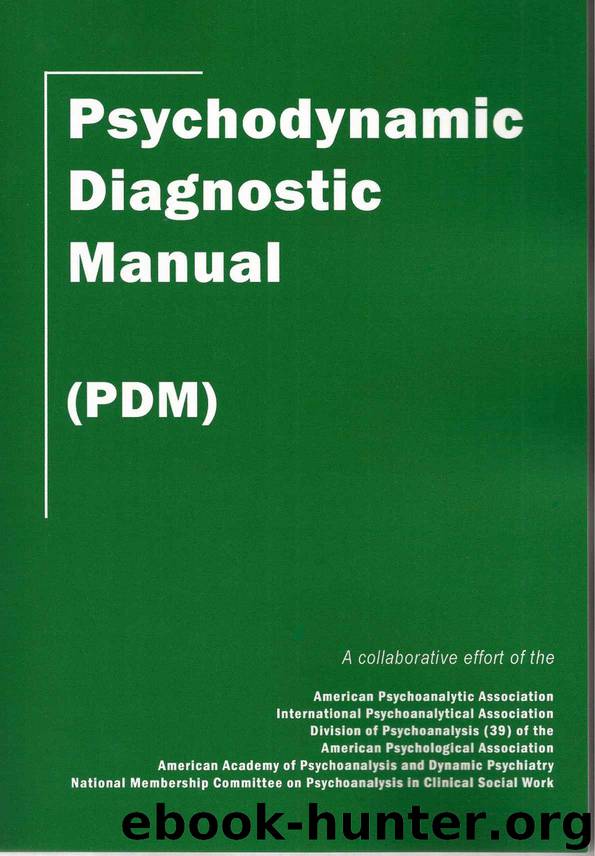Psychodynamic Diagnostic Manual: (PDM) by The Alliance of Psychoanalytic Oraganizations

Author:The Alliance of Psychoanalytic Oraganizations
Language: eng
Format: epub
Publisher: The Alliance of Psychoanalytic Organizations
Published: 2014-03-11T00:00:00+00:00
Clinical Observations
In this stage, which involves a growing intimacy with the primary caregiver(s), one can observe babies who are able to employ all their senses to orchestrate highly pleasurable affect in this relationship. The baby with a beautiful smile, looking at and listening to mother, experiencing her gentle touch and rhythmic movement and responding to her voice with synchronous mouth and arm and leg movements, is perhaps the most vivid example. Clinically, however, we observe babies who are not able to employ their senses to form an affective relationship with the human world. The most extreme case is a baby who actively avoids sensory and, therefore, affective contact with the human world. Human sounds, touches, and even scents are avoided with chronic gaze aversion, recoiling, flat affect, or random or nonsynchronous patterns of brightening and alerting. We also observe babies who use one or another sensory pathway to experience a pleasurable relationship with the human world but who cannot orchestrate the full range and depth of sensory experience. The baby who listens to mother’s voice with a smile but averts his gaze and looks pained at the sight of her face is an example.
Forming an attachment or relationship organizes a number of discrete affective proclivities—comfort, dependency, pleasure, and joy, as well as assertiveness and curiosity in the context of a pleasurable caregiver-infant relationship. In the adaptive pattern, protest and anger are organized along with the expected positive affects as part of a baby’s emotional interest in the primary caregiver. A healthy 4-month-old can, as part of his repertoire, become negative, but then can also quickly return to mother’s beautiful smiles, loving glances, and offers of comfort. Relationship patterns, once formed, continue and develop further throughout the course of life.
By this phase, infants and children can already have major limitations in certain affect proclivities. Rather than evidencing joy, enthusiasm, or pleasure with their caregivers, they may seem emotionally flat. Similarly, rather than evidencing (periodic) assertive, curious, protesting, or angry behavior in relationship to their primary caregiver, they may only look very compliant and give shallow smiles. In addition to being constricted in their affective range, babies may also show a limitation in their organizational stability. An example is a baby who, after hearing a loud noise, cannot return to his earlier interests in the primary caregiver. Where environmental circumstances are unfavorable, or where for other reasons development continues to be disordered, early attachment or relationship difficulties may occur. If these difficulties are severe enough, they may form the basis for an ongoing deficit in the baby’s capacity to form affective human relationships and to form the basic personality structures and functions that depend on the internal organization of human experience.
Download
This site does not store any files on its server. We only index and link to content provided by other sites. Please contact the content providers to delete copyright contents if any and email us, we'll remove relevant links or contents immediately.
The Ultimate Bodybuilding Cookbook by Kendall Lou Schmidt(3906)
Warrior Workouts, Volume 2 by Stewart Smith(2538)
The Right Way to Do Wrong by Harry Houdini(1913)
10% Happier by Dan Harris(1706)
The Doctors Book of Home Remedies by Prevention Magazine Editors(1517)
Steroids: History, Science, and Issues by Standora Joan E.; Bogomolnik Alex; Slugocki Malgorzata(1499)
The Monk Who Sold His Ferrari by ROBIN SHARMA(1439)
The 7 Principles of Stress by Ori Hofmekler(1372)
Spiritual Midwifery by Ina May Gaskin(1352)
Complete Guide to Prescription & Nonprescription Drugs 2014 by H. Winter Griffith(1345)
The Dangerous Case of Donald Trump by Bandy X. Lee(1333)
Joey Green's Magic Health Remedies by Joey Green(1330)
The Ins and Outs of Gay Sex by Stephen E. Goldstone(1319)
Massage Anatomy by Abigail Ellsworth(1244)
First Aid for Colleges and Universities (10th Edition) by Mistovich Joseph J. & Limmer Daniel J. & Karren Keith J. & Hafen Brent Q(1240)
Anatomy of the Moving Body by Theodore Dimon Jr(1235)
The Anatomy of Sports Injuries by Brad Walker(1233)
The Ayurveda Encyclopedia by Swami Sadashiva Tirtha(1179)
Why Do Men Fall Asleep After Sex? by Mark Leyner(1048)
